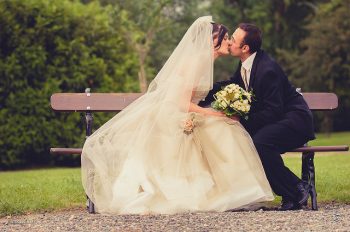How to Celebrate a Jewish Wedding (part 3) Posted by Ayana on Nov 20, 2017 in Uncategorized
In our last post about How to Celebrate a Jewish Wedding, we discussed the essentiality of the chuppah. Today we’ll start to discuss everything that happens under it – the wedding ceremony.
There used to be two different ceremonies (טְקָסׅים): betrothal (קׅידוּשׁׅין) and wedding (נׅישׂוּאׅין). In the past, when a couple got engaged they celebrated it with a short ceremony (טֶקֶס) to announce their union. They let the community know they are not singles anymore and that they chose each other. After the announcement they took the time to prepare them self for marriage life: they found a place to live in, saved money, and got ready to become a family. Only then they celebrated their marriage with a wedding ceremony.
The wedding ceremony (טֶקֶס הַנּׅישׂוּאׅין) of today is composed of these two different sections. Nowadays, these two ceremonies are combined into one ceremony celebrated at one evening. The first section of the חוּפָּה ceremony is the betrothal. The modern Hebrew word for engagement is אׅירוּסׅין, and from the same root derive the words fiancé – אָרוּס, and fiancée – אֲרוּסָה. A more archaic word for engagement was prevailed during the Mishnah period ( 1st century-7th century AD). Back then the word for engagement was קׅידוּשׁׅין (sanctification), because a fiancée was a women who had been sanctified (מְקוּדֶשֶׁת) to her fiancé. When a couple decided to get engaged, they declared it by sanctifying the woman to the man, so other will know this women is with that man. The way to sanctify the woman was by a ring and it required two witnesses for approval.
The engagement sanctification of old times is the first part of the wedding ceremony of our modern times. Like every happy Jewish occasion, it begins with a blessing over the wine:
בָּרוּךְ אַתָּה אֲדֹנָי אֱלֹהֵינוּ מֶלֶךְ הָעוֹלָם בּוֹרֵא פְּרִי הַגָּפֶן
[Blessed are You our God, sovereign of the universe, creator of the vine]
Listen to the blessing over the wine in this video:
Right after the blessing over the wine, without a break, the rabbi continues to the engagement blessing (בִּרְכַּת אֵרוּסִין):
בָּרוּךְ אַתָּה אֲדֹנָי אֱלֹהֵינוּ מֶלֶךְ הָעוֹלָם,
אֲשֶׁר קִדְּשָׁנוּ בְּמִצְוֹתָיו וְצִוָּנוּ עַל הָעֲרָיוֹת,
וְאָסַר לָנוּ אֶת הָאֲרוּסוֹת,
וְהִתִּיר לָנוּ אֶת הַנְּשׂוּאוֹת לָנוּ עַל יְדֵי חֻפָּה וְקִדּוּשִׁין,
בָּרוּךְ אַתָּה אֲדֹנָי מְקַדֵּשׁ עַמּוֹ יִשְׂרָאֵל עַל יְדֵי חֻפָּה וְקִדּוּשִׁין.
In which we bless our God, sovereign of the universe, who sanctified us with his commandment; who prohibited the Jew from being with women other than one’s wife, and allowed the Jew to be with one’s wife by marriage. In the last line we bless again our God who gave His people the right to get engaged and married.
In this video, from a real wedding, the rabbi is blessing over the wine and the engagement blessing:
After the blessing both the groom and the bride need to drink from the wine. First the rabbi gives the full glass of wine to the groom. The blessed glass of wine is always full to the edge, no matter if it’s a Saturday blessed wine or a wedding blessed wine. To respect the blessing we pour the glass to the brim, and fortunately it leaves enough wine for everyone to drink at the end of the wedding ceremony (to read more about this custom check the first part of How to Celebrate a Jewish Wedding). The groom drinks from the glass and returns it to the rabbi. Then it’s the turn of the bride to drink, but the bride and groom aren’t married yet. The bride is still under the responsibility of her mother, so the rabbi gives the glass of wine to the bride’s mother, and she brings the glass closer to the mouth of her daughter to sip from it.
Then the rabbi asks for the ring. The ring’s holder – it can be the groom, his father, his best man, the bride’s nephew, etc – gives the ring to the rabbi. The rabbi asks the groom if he bought the ring with his own money, and the groom answers yes. Then the rabbi presents the ring to the witnesses, and ask them if the ring worth a Pruta. Pruta is an archaic unit of 0.025 gram silver, and this is the minimum amount by which a woman can be sanctified. Only after they answer yes, the rabbi hands the ring to the groom. The bride stretches forward her index finger, and the groom recites:
הֲרֵי אַתְּ מְקֻדֶּשֶׁת לִי בְּטַבַּעַת זוֹ כְּדַת משֶׁה וְיִשְׂרָאֵל
[Here you are sanctified to me with this ring according to Moses and Israel’s religion]
The groom puts the ring on his bride finger, and the rabbi repeats:
מְקֻדֶּשֶׁת מְקֻדֶּשֶׁת מְקֻדֶּשֶׁת
[Sanctified sanctified sanctified]
After the rabbi repeats the word sanctifies three times, the groom and bride are engaged to each other. The crowed usually applauds at that point, but the ceremony continues with the second section: the wedding ceremony. We’ll talk all about the wedding ceremony in our next post on how to celebrate a Jewish wedding.
In the next video is only the first section of the wedding ceremony – טֶקֶס הַקּׅידוּשׁׅין . This video, from a real wedding, includes the first part of the wedding ceremony – the betrothal ceremony:
Text vocabulary
Bride = כַּלָּה
Groom = חָתָן
Ceremony = טֶקֶס
Ceremonies = טְקָסׅים
Wedding ceremony = טֶקֶס הַנּׅישׂוּאׅין
Betrothal ceremony =טֶקֶס הַקׅידוּשׁׅין
Engagement blessing = בִּרְכַּת אֵרוּסִין
Wine = יַיִן
Ring = טַבַּעַת
Rabbi = רַב
Related posts:
How to Celebrate a Jewish Wedding (part 1)
How to Celebrate a Jewish Wedding (part 2)
Keep Calm and Learn Hebrew

Build vocabulary, practice pronunciation, and more with Transparent Language Online. Available anytime, anywhere, on any device.




